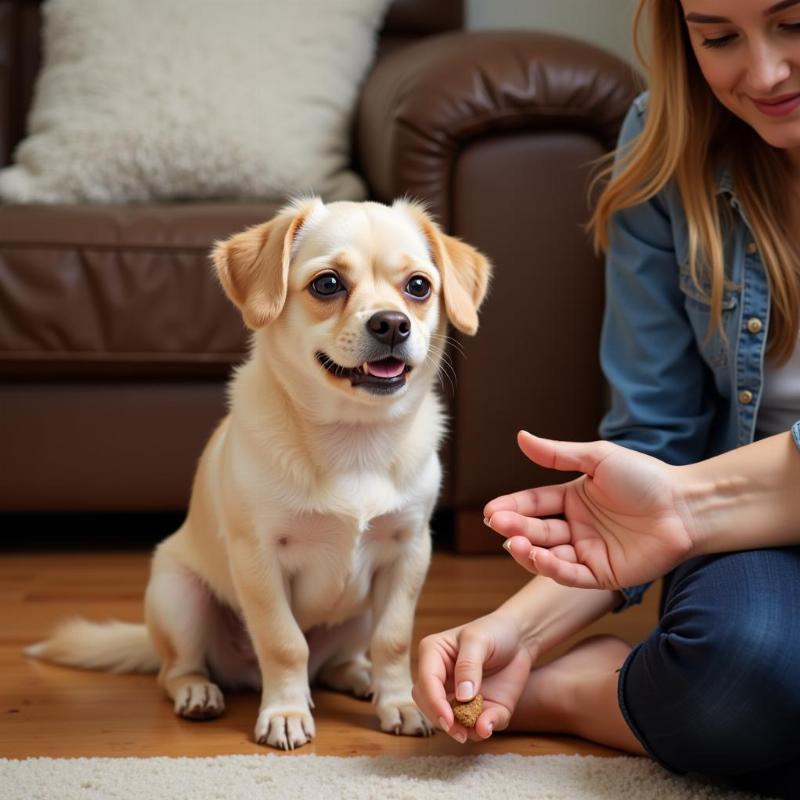Training a dog, whether big or small, is a cornerstone of responsible pet ownership. It fosters a strong bond, ensures safety, and integrates your furry friend seamlessly into your life. While the core principles of training remain consistent across breeds, size does play a role in the specific techniques and considerations. This guide delves into the nuances of big dog little dog training, offering practical advice for navigating the unique challenges and rewards of each.
From housebreaking a tiny Chihuahua to teaching a Great Dane proper leash manners, the journey of dog training is filled with both triumphs and tribulations. Understanding your dog’s size and breed-specific tendencies is crucial for tailoring your approach. A small dog may benefit from positive reinforcement through treats and praise, while a larger breed might respond better to firm but gentle guidance and consistent boundaries. Choosing the right tools, like a long leash for big dogs, can also greatly enhance your training efforts.
Tailoring Training Techniques to Size
Size isn’t just about physical dimensions; it also impacts a dog’s energy levels, strength, and potential for harm. A playful nip from a small dog might be a minor inconvenience, while the same action from a large breed could cause serious injury. This difference underscores the importance of early and consistent training, particularly for larger breeds.
Small Dog Training: Focus on Consistency and Socialization
Small dogs can be prone to developing “small dog syndrome,” a behavioral issue where they become overly protective or demanding due to a lack of proper training. Consistency is key. Establish clear rules and boundaries from day one, and avoid making exceptions based on their cuteness. Early socialization is also essential. Exposing your small dog to a variety of people, places, and other dogs will help them develop confidence and prevent fear-based aggression.
 Small Dog Training Guide
Small Dog Training Guide
Big Dog Training: Emphasize Control and Safety
Training a big dog comes with a heightened responsibility. Their strength and size can pose a safety risk if not properly managed. Early obedience training, focusing on commands like “sit,” “stay,” “come,” and “down,” is vital. Leash training is equally crucial. A well-trained big dog should walk calmly on a leash, without pulling or lunging.
Addressing Common Training Challenges
Regardless of size, certain training challenges are universal. Housebreaking accidents, excessive barking, and destructive chewing are just a few examples.
Housebreaking Hiccups: Big or Small, Accidents Happen
Consistency is crucial for housebreaking any dog. Establish a regular potty break schedule, reward successful potty breaks, and clean up accidents thoroughly to eliminate lingering scents. For smaller dogs, using puppy pads can be helpful during the initial stages of training.
Barking Blues: Understanding the Root Cause
Excessive barking can be triggered by a variety of factors, from boredom and anxiety to territoriality. Identify the underlying cause and address it accordingly. Mental stimulation through puzzle toys and regular exercise can help reduce barking related to boredom.
Destructive Chewing: Providing Appropriate Outlets
Chewing is a natural behavior for dogs, especially puppies. Provide a variety of appropriate chew toys to satisfy this instinct and redirect them away from furniture and other household items.
Big Dog, Little Dog: A Shared Journey of Love and Learning
Dr. Emily Carter, a certified veterinary behaviorist based in Denver, Colorado, emphasizes the importance of individualized training approaches. “While size does influence training strategies,” she explains, “every dog is an individual. Understanding your dog’s unique personality, learning style, and breed-specific traits is key to achieving training success.”
Training a dog, whether big or small, requires patience, dedication, and a positive attitude. Embrace the journey, celebrate the small victories, and remember that the bond you build through training is a priceless reward.
Conclusion
Big dog little dog training presents unique challenges and rewards. By understanding your dog’s size and breed-specific needs, you can tailor your approach for optimal success. Consistency, patience, and positive reinforcement are the cornerstones of effective training, regardless of your dog’s stature. With the right tools and techniques, you can nurture a well-behaved companion and enjoy a harmonious relationship with your furry friend.
FAQ
- Do small dogs need less training than big dogs? No, small dogs still require consistent training to prevent behavioral issues like “small dog syndrome.”
- Is it harder to train a big dog? Not necessarily, but their size and strength require more attention to safety and control.
- What are the best training methods for big dogs? Positive reinforcement combined with firm but gentle guidance is generally effective.
- How can I prevent my small dog from barking excessively? Identify the underlying cause (boredom, anxiety, etc.) and address it accordingly. Provide mental stimulation and exercise.
- What kind of leash is best for a big dog? A sturdy leash designed for large breeds, potentially a long leash for big dogs, can be beneficial.
- Are there any breed-specific training considerations? Yes, certain breeds have inherent traits that may influence training strategies. Research your dog’s breed for specific recommendations.
- What should I do if my dog eats stuffing from a toy? Consult a vet, especially if it’s a large amount, as it could cause a blockage. You can read more about this on our article regarding dog eating stuffing from toy.
Beautdogs.us is your premier destination for all things dog-related in the USA. We offer expert advice on dog care, breed information, product reviews, and much more. Whether you’re a first-time dog owner or a seasoned pro, Beautdogs.us is your trusted resource for building a stronger bond with your canine companion. Contact us today for personalized advice! Email: [email protected], Phone: +1 501-555-7529.